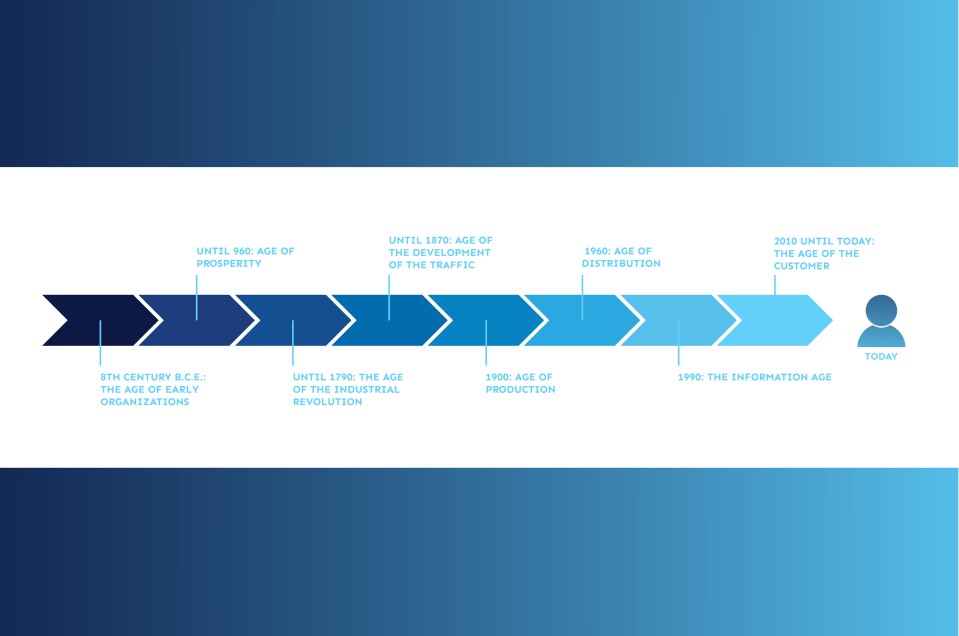Total Quality Manage...
18567 | 6 Apr 2023

Fundamental change is constantly taking place in the business world. Companies anticipating and adapting to these profound changes have the best chance of succeeding in the new era. The nature of business and the marketplace has evolved slowly over many years. The evolution of the market is divided into eras, which generally lasted about 40 to 50 years in the last two centuries. A number of unifying characteristics characterize the eras. Transitions between eras or periods occur over decades but are often not clearly defined, so it is possible to perceive some elements of the previous era also in subsequent eras. In 2020, we were in the Age of the Customers, but it has taken us quite a while to arrive here and become a consumer society.
Below, based on the available literature (Drechsler, 2013; Ekelund and Hebert, 2013; Nunn, 2014; Taimni, 1994; Whitaker, 2010), we have roughly listed the most important periods/eras in the history of business and market development, which we use to show changes in the nature of business circumstances over time:
a) 8th century B.C.E.: The age of Early Organizations
In the eighth century B.C., early organizations called "Shrine" first appeared in India, which then were the first companies that allowed independent contracting and already managed property, which meant that they could also already conduct court proceedings. In ancient India, a "Shrine" was an association of merchants and craftsmen. Generally, there were separate "Shrines" for a particular group of people engaged in the same profession or activity. They were sometimes compared to guilds.
b) Until 960: Age of Prosperity
Around 960, gunpowder, printing presses, and the first paper money appeared in the Chinese Song Dynasty. The tea trade changed the world map. The first partnerships and joint-stock companies were also established, resembling our modern capitalist structures.
c) Until 1790: The Age of the Industrial Revolution
During the Industrial Revolution, companies began inventing methods to standardize processes that were previously done by hand. The division of labor is also introduced. Craftsmen who used to make a product as a whole now focus on making its individual parts. Businesses were started by people rather than just one person, contributing to lower unemployment.
d) Until 1870: Age of the Development of the Traffic
Over the years, business continues to develop. American railroad companies emerged, which can be considered the first modern management organization with paid managers. The advent of railroads significantly lowered the cost of transporting goods, leading to new types of founder-managed trusts that created monopolies in many industries. Trusts were later outlawed in the 1920s and replaced by professionally managed companies owned by small investors and run by influential executives.
e) 1900: Age of Production
The business world revolved around products, distribution and manufacturing. Good, functionally advanced products conquered the market. Business success revolved around the number of products manufactured, or customers served. More products manufactured or more customers served in a short period of time meant a better chance of surviving in the marketplace. All product marketing efforts focus on the features, characteristics, and functions of a particular product and not necessarily on customer needs because the novelty of a particular product has already attracted customers.
f) 1960: Age of Distribution
It was not until the 1960s that the focus of business activity shifted from production to distribution. As globalization accelerated, companies benefited from lower delivery and production costs abroad. As a result, companies began focusing more on delivering their foreign-made products to customers and introducing them to the foreign market. This led to a greater focus on expanding the reach of both products and branding. The age of distribution thus discovered the importance of growth and expansion. The more markets companies entered, the more customers they could reach and the more successful they were. In the era of distribution, companies were already somewhat more "Customer-Centric," or focused on reaching as many customers as possible, than in the previous era of manufacturing, but this focus was not really for the benefit of the customer and focused on the customer experience, but still on maximizing sales.
g) 1990: The Information Age
In the 1990s, technology advanced exponentially, allowing for easier distribution. Competition changed, and the importance of user experience increased. The Information Age marked a new fundamental shift in business. The focus shifted from the industrial side of the business to more information-oriented practices. Computers have become common in offices, and businesses have entered the vast world of information with the Internet. The information age is about replacing production and distribution with knowledge and data. Technology has begun to provide tools that allow companies to understand their customers better. This was the beginning of the rise of today's age.
h) 2010 until today: The Age of the Customer
Over time, customers' needs became increasingly evident, gradually leading to a surplus of supply over demand, which is now considered the customer orientation of companies. Companies must also align part of the processes to use information and software to monitor, control and inform customers. Today, it could be said that companies are, in a sense, obsessed with the customer, meaning that customer needs and customer experience are always at the forefront of marketing.
The Age of the Customer has proven that technology puts the customer in control. In the future, it is expected that as automation and artificial intelligence advance, insight into data and the extraction of information will continue to be of valuable importance. However, it should be emphasized that customer experience will continue to be an essential criterion for the long-term survival of organizations in the marketplace.
What are your thoughts on the subject above? Feel free to post a comment or start a discussion.
Leave A Comment